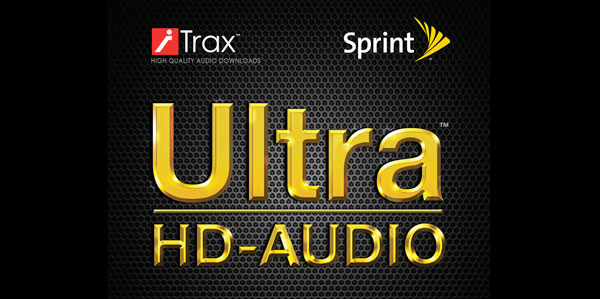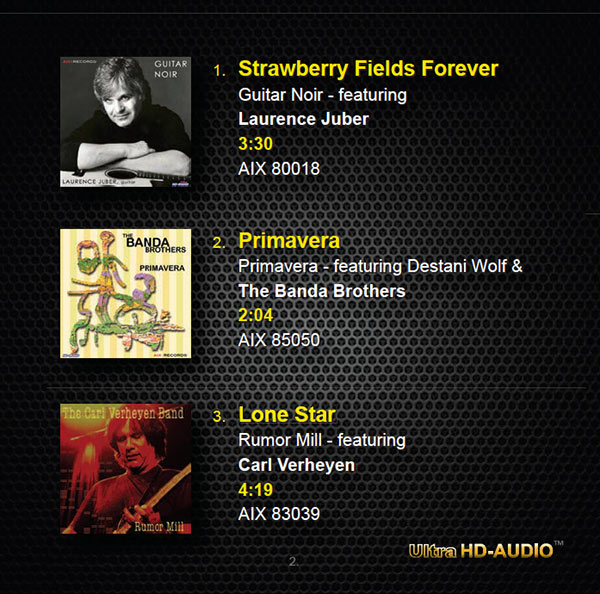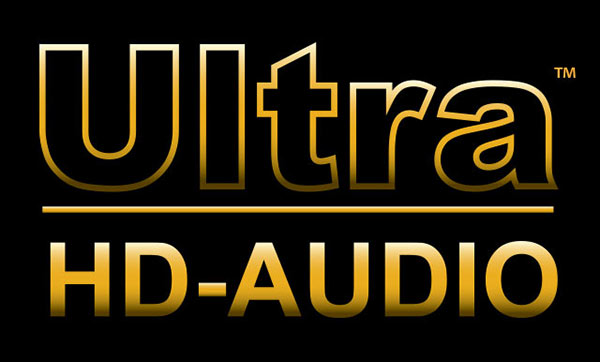Preview: The iTrax-Sprint Ultra HD-Audio Sampler
A few months ago, I received an email from a C-level executive at Sprint. It turns out that he’s a fellow music fan and lifelong audiophile…AND a reader of this blog. He kindly sent me one of their new Harman Kardon Edition HTC One M8 Smartphones to check out. It’s a real winner as I’ve said repeatedly on this site (check out my review at Sprint HTC M8 HKE phone). He introduced me to some of the development and web people at Sprint, which resulted in a ground breaking collaboration between iTrax and Sprint. I am very pleased to pre-announce to readers of this site that the “iTrax-Sprint Ultra HD-Audio Sampler” is now available at the iTrax.com website.
It consists of 18 full length, stereo 96 kHz/24-bit tracks selected from the AIX Records catalog. I picked some of my favorite tracks by some of my favorite musicians including “Let Them In” by John Gorka (the emotional sentiment and heartfelt nature of this very sad song touches everyone), “Strawberry Fields Forever” by Laurence Juber, “Lowlands” by Jamie Hanna and Jonathan McEuen and “Mujaka” by The Latin Jazz Trio (the percussion in this track is to die for). These are tracks that can legitimately be called “Ultra HD-Audio” not only because of the specs (they were all recorded at 96 kHz/24-bit PCM and keep there) but because of the unique methods I’ve developed over the past 40 years of being an audio engineer and musician. No artificial reverberation, no equalization, and only natural dynamics are just a few of the important differences you’ll hear in all of these tracks.
Figure 1 – A sample page from the pdf booklet that accompanies the sampler.
Here’s the full track list (almost 90 minutes of music):
1. Laurence Juber – Strawberry Fields Forever
2. The Banda Brothers – Primavera
3. Carl Verheyen – Lone Star
4. John Gorka – Let Them In
5. Ernest Ranglin – My Boy Lollipop
6. Zephyr – Now Is The Month Of Maying
7. Lowen & Navarro – Cold Outside
8. Jamie Hanna & Jonathan McEuen – Lowlands
9. Albert Lee – Luxury Liner
10. Willie Nelson & Paul Williams – Rainbow Connection
11. Hanna – McEuen – Prayer For You
12. Steve March Tormé – On the Street Where You Live
13. James Walker and Free Flight – Libido
14. The Latin Jazz Trio – Mujaka
15. The Old City String Quartet – Mozart Clarinet Quintet K. 581 – Movt 1
16. Bryan Pezzone – Berceuse
17. G. Enescu Philharmonic Orchestra – Brandenburg Concerto No. 3 Mvt I. Allegro
18. G. Enescu Philharmonic Orchestra – Pavanne for a Dead Princess
And the best part is that the cost for this iTrax-Sprint collaboration is only $10.99. That’s $.61 per track…less than the los resolution tracks on iTunes and way less than the $5 per track from some other high-end download sites. And these recordings are actually high-resolution…no analog tapes transferred to DSD or standard resolution masters upconverted to 96 kHz/24-bits. You can’t hear the difference unless you actually have recordings that are done using state-of-the-art equipment AND a purist approach to production.
Figure 2 – The Ultra HD-Audio Logo indicates that the contents are bona fide high-resolution tracks from inception to delivery.
Please go to the iTrax site, purchase this unique sampler, leave a review, and if you like what you’ve heard…recommend that your friends get a hold of the iTrax – Sprint sampler too. Go to the AIX Records FB page and “like” us…everything helps. The actual release date for this project is next Monday. If you encounter any problems, please let me know.
Thanks to Sprint and all of you for your continuing support.




No surround?
This is a collaboration with Sprint and their device is not surround capable. I may offer them in the future.
Oh, yes.
Are these two channel mixedowns, or have they been re- mastered for stereo?
I’ll buy anyway, but it can be distracting to have instrumets in wierd locations in the two channel mix, especially when listening through headphones, ie drums hard right, as opposed to central to the sound stage.
Every mix that we offer in stereo is a discrete mix from the multichannel masters. They are not foldowns of the multichannel mixes. However, they are derivative of the multichannel mixes. A set of drums is on the right side of the “stage” mix…and on the front right side in the “audience” mix and leaning to the left half of the stereo mix…I do this to be consistent. There’s no rule that says a drum set needs to be spread across the middle of a stereo mix.
I’ve yet to go to a small gig where the drum kit wasn’t behind the rest of the musicians, and I’ve yet to hear any jazz, rock or pop recording (apart from Motown) where the drums are not centre stage; I think for a stereo mix, particularly headphones, there shouldn’t be a loud instrument hard left or right, I find it distracts from the performance.
Dave, recording are not necessarily models of a live concert…in fact, very rarely so. The Allman Brothers, Toto and others have drums off to the side(s). And in reality, all of the sound is being mixed and redirected out a central column of speakers in mono anyways.
The instruments need to be balanced…I place the grand piano on the left half of the mix to equal the drums on the other side. I think you’ll be surprised that they is so much more room in the middle of the mix if the lead vocal, kick drum, snare, bass etc are all vying for the same location.
I find your instrumental separation, after mix down to stereo, very skewed (from your previous BD sampler) and the implication of what you say about the musicians vying for place in the centre suggests the space they occupy is planar rather than having depth; I don’t believe that.
Dave…these are the same mixes as on the BD sampler. I only create the stereo mixes once and whether they are downloaded or put on a disc, they remain the same. On the issue of most recordings having depth, there’s an entire article there. In fact, I believe that I’ve addressed in a previous post. If the recording engineer uses stereo miking technique then you can create a sense of depth. But most commercial recordings don’t use stereo mikes on the drums and instrument and thus can only pan from speaker to speaker…a planar space. It’s a matter of taste whether you want things in the middle or spread out…I prefer to have some room in my stereo mixes. I find stereo very limited.
To be fair, the new sampler is actually very good – even though the higher sampling frequency is giving VLC a bit of a hard time (yes I’me listening using my Note 3, FIIO X3 Ray Samuals, Sennheiser Headphone combination, even though I’ve returned from my holidays..) and the stereo mixes (on this equipment) sound quite acceptable. However, those surround mixes, when translated to stereo makes tracks such as that by Carl Verheyen sound as if they might have been recorded in the 60’s – not necessarily a bad thing.
I’m surprised that you having difficulties with the FLAC files in VLC. You can always convert them to WAV/PCM…that might make a difference. Thanks for the positive comments. The Carl Verheyen track is on the sampler because of the incredible sound of the guitar and especially the drums. Even my wife commented on the incredible presence of the drums. As a wanna be guitar player, Carl’s tone and playing are amazing.
I’m not using FLAC I’m using WAV and downloaded in WAV also. I like the way VLC can key into the ‘phones hardware in a way that (I assume) the built-in Android player doesn’t. However VLC is still in beta on Android and there are some bugs to iron out. Nontheless, VLC sounds markedly superior (even with the bugs) to the built in player irrespective of sampling frequency.
I agree with the sound of the guitar on the Carl Verheyen track, the feel and the mixdown from surround of the track reminds me a little of Fairport Convention.
Blaine beat me to it! I’m a stage-perspective guy as you know – an iTrax sampler from stage-perspective would be a delight.
PS My recent posts about networking music is why I buy the iTrax downloads, rather than the physical disks.
However, why not extend Amazon’s model of letting customers who buy CDs from them stream those CDs on line?
You could give people who buy your DVD-As and Blu-rays a code enabling them to download the music mixes on the disk so they could load them into their network servers.
it would make buying your disks very appealing.
Gentleman, you all know that I’m a surround guy like you. But this is a special collaboration with Sprint and I’m thrilled to have gotten involved with them. I will get something going that ties in the physical discs and a discount code for the downloads…hang in there.